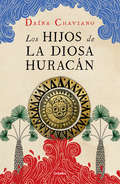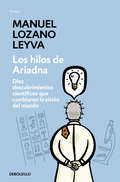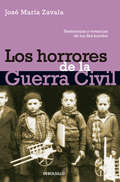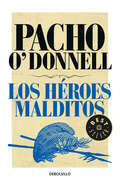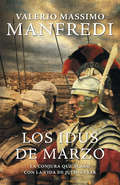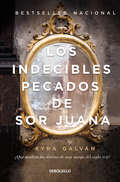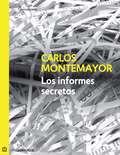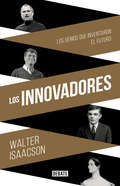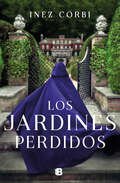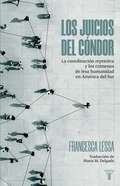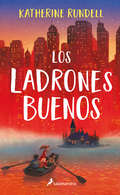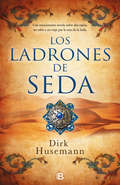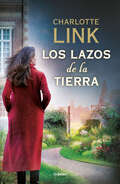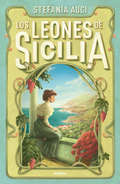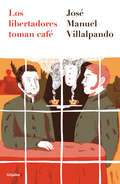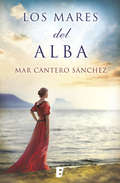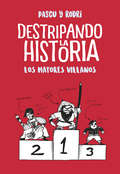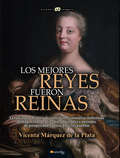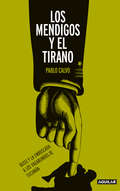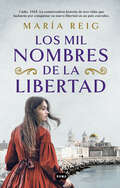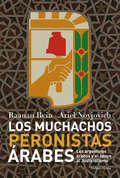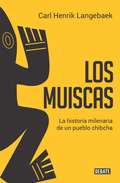- Table View
- List View
Los hijos de la Diosa Huracán
by Daína ChavianoDos mujeres fuertes y valientes, enfrentadas a la codicia, la barbarie y al crimen, se ven unidas a través de los siglos por un misterioso legado que puede alterar el futuro de Cuba. Una apasionante historia que empezó hace más de quinientos años y que solo ahora puede terminar. Alicia Solomon apenas recuerda algo de sus primeros años de vida. Solo sabe que apareció abandonada en una balsa, de muy pequeña, y que fue recogida por unos marineros en alta mar. Ahora, convertida en una experta en documentos antiguos, se enfrenta al mayor reto de su carrera: descifrar un enigmático manuscrito hallado en una misteriosa tumba indígena no muy lejos de La Habana; una tarea que se vuelve más peligrosa a medida que Alicia se da cuenta de que hay personas dispuestas a matar para que ese texto, escrito por una mujer desconocida en el siglo XVI, jamás vea la luz. Y es que, más de quinientos años atrás, existió un testigo excepcional de la conquista española. Juana, una joven recién llegada a la isla de los huracanes, se convirtió en la voz de esos pueblos sometidos y en el origen de una dinastía valerosa y justa, perseguida por quienes aún hoy no dudarán en eliminar a cuantos se opongan a su codicia y a su insaciable sed de poder. Una aventura plagada de secretos, enigmas, mitos y conspiraciones, que retrata la eterna lucha entre la dignidad y la opresión, entre la inocencia y la más depravada codicia.
Los hijos de la Diosa Huracán
by Daína ChavianoDos mujeres fuertes y valientes, enfrentadas a la codicia, la barbarie y al crimen, se ven unidas a través de los siglos por un misterioso legado que puede alterar el futuro de Cuba. Una apasionante historia que empezó hace más de quinientos años y que solo ahora puede terminar. Alicia Solomon apenas recuerda algo de sus primeros años de vida. Solo sabe que apareció abandonada en una balsa, de muy pequeña, y que fue recogida por unos marineros en alta mar. Ahora, convertida en una experta en documentos antiguos, se enfrenta al mayor reto de su carrera: descifrar un enigmático manuscrito hallado en una misteriosa tumba indígena no muy lejos de La Habana; una tarea que se vuelve más peligrosa a medida que Alicia se da cuenta de que hay personas dispuestas a matar para que ese texto, escrito por una mujer desconocida en el siglo XVI, jamás vea la luz. Y es que, más de quinientos años atrás, existió un testigo excepcional de la conquista española. Juana, una joven recién llegada a la isla de los huracanes, se convirtió en la voz de esos pueblos sometidos y en el origen de una dinastía valerosa y justa, perseguida por quienes aún hoy no dudarán en eliminar a cuantos se opongan a su codicia y a su insaciable sed de poder. Una aventura plagada de secretos, enigmas, mitos y conspiraciones, que retrata la eterna lucha entre la dignidad y la opresión, entre la inocencia y la más depravada codicia. Reseña:«He disfrutado mucho de Los hijos de la diosa huracán de Daína Chaviano. Un thriller histórico trepidante que pone en valor el legado de los pueblos indígenas anteriores a la colonización española al tiempo que plantea una intriga actual intensa y adictiva. Bien documentada, emocionante y fantásticamente escrita.»Ildefonso Falcones
Los hilos de Ariadna: Diez descubrimientos científicos que cambiaron la visión del mundo
by Manuel Lozano LeyvaLos diez descubrimientos científicos que cambiaron la visión del mundo. La ciencia es un universo fascinante lleno de sorpresas. Un territorio donde reina la aventura del conocimiento y los descubrimientos constituyen pilares esenciales para el progreso humano. Este es el hilo conductor que guía al profesor Lozano Leyva -uno de los físicos más prestigiosos del país- en su afán por acercarnos diez hallazgos científicos de la historia con un lenguaje accesible y lleno de guiños inteligentes. De la posibilidad de vida extraterrestre tomando como principio las condiciones que facilitaron la vida en la Tierra a las estrellas y su movimiento; de la piedra Rosetta -aquella que la expedición napoleónica encontró en Egipto y cuyos jeroglíficos descifró Champollion- a la colección de microscopios de Van Leeuwenhoek, esencial para el avance de la medicina; de la genética moderna a la sorprendente historia del "cero" y su influencia en la psicología, el arte, la matemática y la filosofía, Lozano Leyva ha escrito un libro apasionante, lleno de ideas y sugerencias que hará las delicias de cualquier aficionado a la ciencia y sus misterios. Reseña:«Lozano Leyva ha escrito un libro entretenido y de lenguaje claro que ayuda a acercarse a la ciencia.»Santiago Belausteguigoitia, El País
Los horrores de la Guerra Civil: Testimonios y vivencias de los dos bandos
by José María ZavalaEl lado oscuro y menos conocido de la Guerra Civil, a través de diversos testimonios de los horrores y excesos cometidos por ambos bandos en la retaguardia. Este libro no dejará indiferente a nadie. A partir de más de doscientos testimonios y vivencias estremecedoras de los dos bandos, Los horrores de la Guerra Civil propone una lectura de la historia que atiende a aquellos que normalmente no tienen lugar en los libros. Sus protagonistas son personas con nombres y apellidos que no murieron en el frente, sino vilmente asesinadas en las retaguardias nacional y republicana. Los horrores de la trágica Guerra Civil, reunidos por primera vez en una impresionante obra, en la que el lector hallará también un completo diccionario de la represión, así como la biografía de los principales políticos y militares de aquel terrible enfrentamiento, y una extensa bibliografía y una rigurosa cronología de los acontecimientos más destacados. Un trabajo exhaustivo y ecuánime, en suma, que, dejando a un lado los intereses partidistas y las disputas de los historiadores por dirimir cuál de los dos bandos asesinó más, se ocupa de los auténticos protagonistas: las víctimas. Reseña:«Una obra original y de gran envergadura, recomendable por su objetividad y ausencia de espíritu partidista.»Stanley G. Payne
Los héroes malditos
by Pacho O'DonnellPacho O'Donnell nos introduce en las vidas de los hombres y las mujeres que lucharon a favor de los sectores populares, contra el poder de turno, y que la historia oficial ha ocultado bajo un manto de silencio. En las páginas de Los héroes malditos desfilan los pueblos originarios y sus caciques, que hostigaron tenazmente a los colonizadores europeos; las mujeres que combatieron a la par de los hombres; los jefes populares como Bohorques, Artigas, Dorrego, Campana, Moldes; los heroicos y olvidados caudillos altoperuanos; Juan Manuel de Rosas y su Confederación; los caudillos provinciales y su lucha por una organización federal; y también nuestro prócer máximo, San Martín, a quien la historia oficial ha exaltado al precio de mutilar sus ideas, que lo condenaron al exilio interminable. Pacho O'Donnell nos demuestra que la historia que nos enseñaron posterga o suprime a aquellos personajes y movimientos que han tenido el favor de los sectores populares, con cuya fuerza han puesto en peligro al poder de turno. Ya lo decía Rodolfo Walsh: "Nuestras clases dominantes han procurado siempre que los humildes no tengan historia, no tengan doctrina, no tengan héroes ni mártires (...) La historia aparece así como propiedad privada cuyos dueños son los dueños de todas las otras cosas".
Los idus de marzo: La conjura que acabó con la vida de Julio César
by Valerio Massimo ManfrediUna visión nueva de uno de los acontecimientos más impactantes y dramáticos de la Historia Antigua: el asesinato de Julio César. «¡Guárdate de los idus de marzo!» Esta fue la célebre advertencia que hizo un adivino a Julio César, infausto presagio de lo que iba a suceder. El complot ya estaba urdido y los conspiradores decididos a dar el golpe fatal. Tampoco las palabras de aviso del adivino fueron las únicas que escuchó César en los días previos al asesinato, pero era tan grande su confianza que las rechazó. En muchos aspectos la de César fue una muerte anunciada. Esta obra de Valerio Massimo Manfredi es la crónica implacable de las cuarenta y ocho horas anteriores al sangriento acontecimiento que había de cambiar la historia. En ella todos los personajes -desde César hasta Porcia, desde Cicerón hasta Bruto, la mano ejecutora- van asumiendo su papel con la tensa cadencia de una tragedia griega. Y es que a veces la historia es la mejor novela... Reseña:«Una gran historia, que no solo tiene el poder de la fascinación, sino que además invita a una reflexión sobre el poder, el destino y la política: una novela histórica en presente.»Il Messaggero
Los indecibles pecados de Sor Juana
by Kyra Galván¿Qué ocultan los diarios de una monja del siglo XVII? Laura descubre por casualidad los diarios de una monja jerónima del siglo XVII, en el Archivo General de Indias, en Sevilla. Esto la lleva a involucrarse en una vorágine, que amenaza su vida, pues hallará más de un secreto que la Iglesia católica ha querido ocultar durante siglos; entre ellos, una misión diplomática y una provocativa pintura que ha permanecido oculta. En tanto que Los indecibles pecados avanza a ritmo vertiginoso, el lector descubre a una Sor Juana de cuerpo entero, con dudas, pasiones y amores clandestinos. Con esta novela Kyra Galván se consolidó como una escritora con voz propia y un singular mundo narrativo donde habita el erotismo. «Una historia en la que el pasado -Sor Juana, su vida y sus pasiones- se mezcla con la actualidad en manos de la historiadora Laura Ulloa, quien pronto se ve en problemas con la Iglesia católica y la monarquía española a causa de su descubrimiento» La Jornada
Los informes secretos: Novela (Narradores Contemporáneos/jm Ser.)
by Carlos MontemayorUna escalofriante novela inspirada en los mecanismos del aparato de seguridad en México. Una novela que explora las entrañas del sistema político mexicano y que muestra cómo nacen las rebeliones sociales. Esta obra tiene su origen en los informes y la experiencia de un agente de los aparatos de seguridad en México. Aquí se ilustra el modo en que operan tanto los movimientos clandestinos como los dispositivos de coerción del Estado. También aparecen nombres reales de gente poderosa y los contextos políticos en que se mueven. Se ofrece además una perspectiva tangible de numerosos acontecimientos que para un ciudadano común pueden ser espeluznantes, y se dan a conocer documentos oficiales que estaban prohibidos. El poderío político y la megalomanía de algunos líderes se muestran en este libro, así como hechos que pueden parecer inverosímiles.
Los innovadores: Los genios que inventaron el futuro
by Walter IsaacsonEn una era que busca fomentar la innovación, la creatividad y el trabajo en equipo, Los innovadores es la obra que mejor muestra cómo se producen. Tras su extraordinaria biografía de Steve Jobs, el nuevo libro de Walter Isaacson cuenta la fascinante historia de las personas que inventaron el ordenador e internet; Los innovadores está destinado a convertirse en la historia definitiva de la revolución digital y en una guía indispensable para entender cómo sucede realmente la innovación. ¿Qué talentos y habilidades permitieron a algunos inventores y empresarios convertir sus ideas visionarias en realidades disruptivas? ¿De dónde vinieron esos saltos creativos? ¿Por qué algunos triunfaron y otros fracasaron? En esta magistral saga, Isaacson arranca con Ada Lovelace, la hija de lord Byron, una pionera de la programación informática en la década de 1840. Además, presenta a las extraordinarias personas quecrearon la revolución digital que nos rodea, gente como Vannevar Bush, Alan Turing, John von Neumann, J.C.R. Licklider, Doug Engelbart, Robert Noyce, Bill Gates, Steve Wozniak, Steve Jobs, Tim Berners-Lee o Larry Page. Esta es la historia de cómo funcionan sus cerebros y por qué han sido tan inventivos, pero también de cómo su capacidad para colaborar y dominar el arte del trabajo en equipo les hizo aún más creativos.
Los jardines perdidos
by Inez Corbi«Un jardín de ensueño que conecta a dos mujeres a lo largo del tiempo. Romántico y emocionante.» Sarah Lark Unos jardines que ocultan un gran secreto.Una saga familiar llena de pasiones y misterio.Una historia de amor que vence el paso del tiempo. 1781: Damaris y Allie son dos hermanas huérfanas a quienes su primo, Henry Tremayne, ha acogido en la mansión de Heligan. Apasionado de la botánica, Henry quiere cumplir su sueño de crear un jardín exótico en las tierras de la familia. Para ello, no solo cuenta con la ayuda de Damaris, gran conocedora de los secretos de las plantas y las flores, sino que está decidido a recorrer todos los jardines de Inglaterra en busca de inspiración. Pero Damaris esconde una verdad que la atormenta: está irremediablemente enamorada de Julian, el guardabosques, un hombre al que rescataron de un naufragio en las costas de Cornualles y que guarda una tragedia que le impide corresponder a su amor. Dos siglos más tarde una joven londinense llega a Cornualles bajo un nombre falso, intentando huir de su pasado. En los Jardines Perdidos de Heligan, donde empieza a colaborar como voluntaria, encuentra su refugio. Muy pronto se ve inmersa en la historia de ese espacio maravilloso y lleno de magia que ha permanecido abandonado durante décadas. Cuando le piden que organice la celebración del aniversario de los Jardines, comenzará a descubrir la extraordinaria historia de dos hermanas que los habitaron en una época lejana y el poder invencible del amor.
Los juicios del cóndor: La coordinación represiva y los crímenes de lesa humanidad en América del Sur
by Francesca LessaUna reconstrucción histórica minuciosa del Plan Cóndor y, con ello, devela la tra-ma intergubernamental de persecución política en el Cono Sur de América Latina. En Los juicios del Cóndor, Francesca Lessa —académica referente en el estudio de los derechos humanos en América Latina— presenta una investigación exhaustiva sobre la represión transnacional coordinada por las dictaduras sudamericanas en la década del setenta y principios de los ochenta, así como los procesos posteriores de búsqueda de verdad y justicia, principalmente en el Cono Sur. Mediante el análisis de más de tres mil documentos, la realización de ciento cinco entrevistas y el seguimiento de procesos judiciales —sobre todo en Argentina e Italia—, la autora revela la naturaleza compleja de los delitos extraterritoriales, los entresijos del funcionamiento de la justicia en los distintos países involucrados y los esfuerzos internacionales para sortear la impunidad.
Los ladrones buenos
by Katherine RundellNueva novela de una de las grandes novelistas juveniles anglosajonas. Cuando Vita Marlowe aterriza en Nueva York, ciudad a la que ha viajado con su madre desde Inglaterra, ignora que está a punto de emprender una arriesgada aventura para ayudar a su querido abuelo Jack Welles. Un famoso estafador con conexiones con la mafia lo ha engañado y el anciano ha perdido su casa y todas sus posesiones. Su nieta hará lo imposible para hacerle sonreír de nuevo. Con ese objetivo en mente, Vita urde un plan con la ayuda de una joven carterista y dos talentosos aprendices del circo, ambos amantes de los animales y capaces de desafiar la gravedad con sus excepcionales habilidades. Rápidamente los cuatro amigos se verán envueltos en una intriga repleta de emoción para recuperar el hogar de Jack. La nueva novela de Katherine Rundell es una historia trepidante y apasionada, con elementos de luces y sombras, protagonizada por un grupo de niños unidos contra el mal y la injusticia. Reseñas:«Rundell es una de las mejores escritoras de literatura juvenil que hay en este momento, y si aún no la has descubierto, este libro divertido y adictivo es una gran opción para comenzar. Es probable que sea el mejor libro juvenil que leerás este año.»The Times «Una historia deslumbrante llena de esperanza, dolor, valentía y amor intergeneracional.»Publishers Weekly (reseña destacada) «Rundell tiene un don para las descripciones precisas y hermosas. El libro está lleno de escenas bellas y sorprendentes, como la del caballo blanco galopando por la ciudad a primera hora de la mañana, así como de un generoso sentido de la aventura y el compañerismo. Rundell usa, y subvierte ligeramente, la clásica historia de la búsqueda del tesoro.»Literary Review «Los buenos ladrones es un libro de intriga maravillosamente escrito que deleitará a los seguidores de Rundell.»TheTelegraph «Su última entrega no sólo es adictiva, sino que es un placer leer cada frase.»Sunday Times «Esta novela es tan convincente como una aventura circense de Enid Blyton: si Blyton hubiera escrito con compasión y con una prosa limpia y elegante, en la que es un placer sumergirse... Escarceos mafiosos, hazañas impresionantes y una atmósfera trepidante de principio a fin, hacen que sea una delicia para leer de una sentada. Sin duda Rundell está en la cumbre de su talento.»The Guardian «Rundell orquesta una acción trepidante y emocionante, con unos personajes vívidos y entrañables, con la precisión de un relojero.»Daily Mail «Con una trama apasionante y unos personajes inolvidables, lo último de Rundell es otro triunfo.»Mail on Sunday «Bellamente escrito y con una trama perfecta.»The Times Saturday Review «Katherine Rundell se hizo un nombre con la multipremiada Sophie en los cielos de París y es una de las autoras infantiles más talentosas que existen.»Daily Express «Con un ritmo rápido y una redacción aguda, con generosas dosis de emoción y humor, la nueva novela de Rundell atraerá a los lectores amantes de las grandes aventuras y con un fuerte sentido de la justicia.»Bookpage
Los ladrones de seda
by Dirk HusemannEl primer robo de guante blanco históricamente documentado se convierte, a manos de Dirk Husemann, en una emocionante novela repleta de aventuras. Bizancio, año 552 de nuestra era. Dos espías romanos disfrazados de monjes persas, Taurus y Olympiodorus, viajan a China con la intención de robar su secreto más preciado: la manera de producir la seda. El comercio de tan delicado y preciado material es una de las mayores fuentes de ingresos para el Imperio romano, pero desde que el emperador Justiniano inició la guerra con Persia, las rutas han quedado bloqueadas. Los dos espías consiguen robar unos gusanos y huyen por la ruta de la Seda, la ruta comercial más larga del mundo y fuente de ingresos para muchos comerciantes que, cuando descubren el robo, ven peligrar su monopolio. Pronto, grandes recompensas se ofrecen por la captura de los bandidos. Pero el peor enemigo para los dos ladrones no son aquellos que les persiguen, sino el tiempo. Si las preciosas mariposas salen de sus capullos mientras están de viaje, morirán. Y si los ladrones vuelven a Bizancio con las manos vacías, sus cabezas no tendrán ningún precio. La crítica ha dicho sobre el autor y su obra...«La redacción de un estilo muy legible evidencia que el autor, como periodista científico, es capaz de transmitir hechos y circunstancias complejas de un modo popular y comprensible.»Münchner Merkur «Una fascinante novela de aventuras ambientada en la época de Carlomagno.»Sabine Jünemann, Delmenhorster Kreisblatt «En Un Elefante para Carlomagno, su primera novela, Dirk Husemann ha transformado una auténtica misión diplomática en un fascinante novelón histórico. Y mediante un fluido estilo literario el periodista científico vuelve comprensibles hechos y circunstancias complejos »Frankfurter Neue Presse
Los ladrones de seda
by Dirk HusemannEl primer robo de guante blanco históricamente documentado se convierte, a manos de Dirk Husemann, en una emocionante novela repleta de aventuras. Bizancio, año 552 de nuestra era. Dos espías romanos disfrazados de monjes persas, Taurus y Olympiodorus, viajan a China con la intención de robar su secreto más preciado: la manera de producir la seda. El comercio de tan delicado y preciado material es una de las mayores fuentes de ingresos para el Imperio romano, pero desde que el emperador Justiniano inició la guerra con Persia, las rutas han quedado bloqueadas. Los dos espías consiguen robar unos gusanos y huyen por la ruta de la Seda, la ruta comercial más larga del mundo y fuente de ingresos para muchos comerciantes que, cuando descubren el robo, ven peligrar su monopolio. Pronto, grandes recompensas se ofrecen por la captura de los bandidos. Pero el peor enemigo para los dos ladrones no son aquellos que les persiguen, sino el tiempo. Si las preciosas mariposas salen de sus capullos mientras están de viaje, morirán. Y si los ladrones vuelven a Bizancio con las manos vacías, sus cabezas no tendrán ningún precio. La crítica ha dicho sobre el autor y su obra...«La redacción de un estilo muy legible evidencia que el autor, como periodista científico, es capaz de transmitir hechos y circunstancias complejas de un modo popular y comprensible.»Münchner Merkur «Una fascinante novela de aventuras ambientada en la época de Carlomagno.»Sabine Jünemann, Delmenhorster Kreisblatt «En Un Elefante para Carlomagno, su primera novela, Dirk Husemann ha transformado una auténtica misión diplomática en un fascinante novelón histórico. Y mediante un fluido estilo literario el periodista científico vuelve comprensibles hechos y circunstancias complejos »Frankfurter Neue Presse
Los lazos de la tierra (La estación de las tormentas #Volumen 3)
by Charlotte LinkEl legado de una mujer excepcional y su familia a través de tiempos convulsos. Tercera entrega de «La estación de las tormentas», una saga familiar que ha entusiasmado a más de 1.500.000 de lectoras. Felicia Lavergne sigue dirigiendo su próspero negocio pero sabe que su tiempo se acaba y que tendrá que dejar el mando a los jóvenes. Sus hijas no están preparadas para asumir su legado. Belle vive en Estados Unidos desde el final de la Segunda Guerra Mundial pero nunca se ha adaptado a ese país. Siempre está deprimida y ahoga sus penas en alcohol. Susanne, por su parte, vive distanciada de sus hijas con quienes ha sido incapaz de afrontar el trauma de un esposo y padre criminal de guerra nazi. Finalmente será Alexandra quien siga los pasos de su abuela. Parece que Felicia ha tomado la decisión correcta y ha puesto su herencia en buenas manos, hasta que una tragedia inesperada lo cambia todo ... Los lazos de la tierra es la última etapa de un emotivo viaje a través de la historia de una familia, durante un siglo terrible y apasionante. Sobre Los aromas perdidos:«Esta novela es una montaña rusa de emociones. Son tantos los personajes a los que el destino les tiene reservadas sorpresas [...] que acabas involucrándote en sus vidas y empatizando y sufriendo con y por ellos. De nuevo ha sido un placer sumergirme en la pluma de Charlotte Link y desde el momento en el que cerré el libro, se ha convertido en mi favorito de la autora.»bitacorademislecturas.blogspot.com
Los leones de Sicilia
by Stefania AuciLos Florio, una poderosa dinastía convertida en leyenda que dejó su huella en la historia de Italia. Ignazio y Paolo Florio llegan a Palermo en 1799 huyendo de la pobreza y de los terremotos que sacuden su tierra natal, en Calabria. Aunque los comienzos no son fáciles, en poco tiempo los hermanos consiguen convertir su tienda de especias en la mejor de la ciudad. Decididos y tenaces, expanden el negocio con la seda que traen de Inglaterra y no tardarán en comprar las tierras y los palacios de la aristocracia arruinada. Cuando Vincenzo, el hijo de Paolo, tome las riendas de la Casa Florio, el avance será ya imparable: con su propia compañía naviera llevarán el Marsala de sus bodegas hasta los paladares más exquisitos de Europa y América. En Palermo su ascenso se observa con asombro, pero también con envidia y desprecio. Durante décadas seguirán considerándolos una familia de «extranjeros» cuya «sangre apesta a sudor». Nadie es capaz de comprender hasta qué punto en el corazón de los Florio late un ardiente deseo de éxito social que condicionará sus vidas durante generaciones, para bien y para mal. La novela revelación del año 2019 en Italia. «Me ha conquistado esta extraordinaria historia de los Florio, una familia de humildes comerciantes que se convirtieron en los reyes sin corona del Palermo del siglo XIX.» Ildefonso Falcones. Reseñas:«Un relato fascinante de la Historia en mayúsculas y la historia privada y moral de una familia de leyenda.»Vanity Fair «Escrita con delicadeza y apoyada por amplias investigaciones históricas. Nadie puede escaparse de la fascinación de la saga familiar de los Florio.»Gazzetta del Sud «Una epopeya familiar que se huele, se toca, se mira, antes de ser leída. [...] Una fragancia agridulce que catapulta al lector a una historia emocionante. [...] El talento narrativo de la autora convierte la epopeya de los Florio -de por sí fascinante- en una vivencia única e irresistible, que se vive como una verdadera aventura.»L'Opinione «Esta saga familiar siciliana [...] podría ser el inicio de un pequeño fenómeno. [...] el hecho de que una historia un poco a lo Gatopardo guste a miles de lectores en el año del Señor de 2019 [...], ya es noticia. [...] es un signo de que a veces apostar por algo un poco distinto puede no ser mala idea.»Il Commento «Hace mucho tiempo que no leía nada parecido: una gran historia y buena literatura. Las vicisitudes y los sentimientos se sostienen en una escritura sólida, madura y llena de pasión y de gracia. Stefania Auci ha escrito una novela maravillosa e inolvidable.»Nadia Terranova «Emocionante y documentada, habla de valor y ambición, de sentimientos y de maldiciones y es la sorpresa de la temporada.»TTL - La Stampa «Historias de amor, de sueños, de traiciones y de esfuerzo en una novela vibrante de vida.»Marie Claire «Una escritura visual que nos sumerge en los lugares y en la historia, que no cae en el sentimentalismo, lúcida e incluso despiadada. Con ecos del Gatopardo y de las novelas históricas de Camilleri.»Famiglia Cristiana
Los libertadores toman café
by José Manuel VillalpandoEl 10 de mayo de 1824, en el Royal Coffee de la ciudad de Londres, conversaron Agustín de Iturbide, libertador y primer emperador de México, y José de San Martín, libertador de Chile y Perú. Jamás volvieron a encontrarse. Dicha reunión es un hecho histórico prácticamente desconocido. En esta novela dialogada, José Manuel Villalpando reconstruye desde la ficción el episodio con el cuidado, metódico y preciso, de poner en las propias palabras de sus personajes ideas expresadas en fuentes primarias, y plantea la «conjetura verosímil» de que durante esa charla de café los ilustres personajes hablaron sobre el régimen monárquico (una aventura fallida del mexicano y un anhelo oculto del sudamericano), además de reconocer sus similitudes ideológicas y referirse al inminente viaje de retorno a su patria que habría de emprender el exemperador. El relato se complementa con la conversación paralela entre Mariano Michelena y Carlos María Alvear, dos espías masones que acuden al mismo café, a prudente distancia, para intentar captar la información que cruzan los libertadores. Para desgracia de Iturbide, son los únicos que conocen la conjura que culminará en su fusilamiento, apenas unos días después de pisar tierras mexicanas.
Los mares del alba
by Mar Cantero SánchezEsta es la historia de Isabel, una mujer sabia, o mal llamada bruja, en los convulsos primeros años del siglo XVII, y que demostrará la fuerza y valía que toda mujer posee en su interior y que no puede ser callada ni siquiera por una institución tan poderosa como la Inquisición. A principios del siglo XVII, Isabel y Ana son dos hermanas de un pueblo del Levante español a las que sus padres esconden para protegerlas de los hombres que vienen por ellas. Isabel, la mayor, intuye que no volverá a ver a sus progenitores. Su padre le dijo una última frase antes de ocultarlas: «Ve hacia el mar.» A la mañana siguiente, las niñas huyen del pueblo, que ven totalmente arrasado... Tras una noche en el bosque, finalmente llegan al mar, y allí las encuentra Joan. Este las acoge como un padre, consciente de que Isabel nunca se recuperará y que, además, buscará venganza. Joan trabaja haciendo perfumes y esencias, y Ana e Isabel lo acompañan por los pueblos de la comarca. Un día, en Altea, Isabel, ya una adolescente, advierte que un chico la observa, y se pone nerviosa. El chico se acerca a saludarla e intenta conversar con ella. Con el paso de los días, Isabel empieza a sentir por él algo que nunca había sentido por nadie. Una noche en que no consigue conciliar el sueño, acechada por las pesadillas que la persiguen desde la muerte de sus padres, Isabel camina hasta la playa y allí ve a unas mujeres que llegan desde diferentes puntos, y se acerca para averiguar qué están haciendo. Ve que bailan alrededor de una hoguera y que, de pronto, muchas de ellas, desnudas, introducen en su cuerpo una hierba que al parecer les provoca un placer irresistible. Se queda observando, fascinada, y de súbito ve a una mujer que la ha descubierto.Asustada, huye de regreso al hogar.
Los mayores villanos (Destripando la historia #Volumen)
by Rodrigo Septien Alvaro PascualDescubre el lado más villano y canalla de nuestra historia. <P><P>¿Crees que lo sabes todo sobre los mayores villanos que han marcado la historia a lo largo de los años? ¿Sabes de dónde provienen los grandes mitos de la maldad humana? ¿Crees que la corrupción es solo cosa del presente? <P><P>Nunca te han contado la historia de esta forma. Este libro te desvela, te descubre y te destripa el origen de las personas más desleales, infames, indignas y fascinantes de nuestra historia. ¡Con todo el humor y las ilustraciones desternillantes de su famoso canal de YouTube!
Los mejores reyes fueron reinas (Historia Incógnita)
by Vicenta Márquez de la PlataLa fascinante historia de siete ilustres monarcas femeninas protagonistas de reinados admirables y periodos de prosperidad y gloria para sus pueblos. Al indagar en el devenir de las principales monarquías pronto se hizo patente que las personalidades seductoras y llamativas y los reinados más admirables, eficientes y «útiles», si es que pude usarse ese adjetivo refiriéndose a reinados, fueron los de algunas reinas. Ha habido muchas menos reinas que ejerciesen la auctoritas y la potestas, que reyes, sin embargo el resultado de ejercicio de la potestas es abrumador a favor de estas. También ejercieron, y a veces muy duramente, la Razón de Estado, no entramos en su calificación moral, simplemente si sus acciones fueron o no útiles para el Estado. Entre los mejores monarcas, ellas gobernaron mejor, fueron más amadas de sus pueblos y su personalidad fue más interesante. ¿Casualidad? ¿Circunstancias? No entraremos en eso, simplemente hablaremos de ellas y que el lector juzgue.
Los mendigos y el tirano
by Pablo CalvoBussi y la emboscada a los vagabundos de Tucumán. «Hace mucho oí unos pocos detalles del episodio pero no encontré a nadie que supiera contarlo, hasta que a fines de 2003 el historiador Eduardo Rosenzvaig me hizo llegar precisiones tan delirantes que estarían fuera de lugar en las novelas. Sucedió poco antes o poco después de una visita protocolar a Tucumán del presidente de facto Jorge Rafael Videla. El gobernador militar de la provincia era Antonio Domingo Bussi, un maniático de la limpieza y un feroz exterminador de disidentes [...]. Fuese o no para impresionar a Videla, el pequeño tirano Bussi impartió aquel invierno de 1977 la orden de recoger a todos los mendigos de Tucumán en un camión militar y arrojarlos en los descampados de Catamarca.» Tomás Eloy Martínez Este libro es la crónica detallada de ese "episodio" y su largo reguero de derivaciones, que incluyen el juicio que el ex gobernador Bussi emprendió contra el escritor y periodista Tomás Eloy Martínez a propósito de las palabras citadas. En su apasionante relato, fruto de una pormenorizada investigación, Pablo Calvo devuelve la presencia, el rostro y la voz a los protagonistas involuntarios del hecho (Pachequito, Vera, el Loco Perón, la Alemana, Mannix, Satélite, entre tantos otros mendigos tucumanos "deportados"), da cuenta del coraje de quienes supieron denunciarlo y aporta una reflexión, siempre presente, sobre el derecho y el compromiso de llamar las cosas por su nombre.
Los mil nombres de la libertad
by María ReigCádiz, 1815. Tres vidas marcadas por las consecuencias de la guerra de la Independencia y el nacimiento del estado liberal. ¿Cuál es el verdadero nombre de la libertad? Año 1815.Un momento histórico convulso.Una mujer dispuesta a salvar a su familia. ¿Cuál es el verdadero nombre de la libertad? 1815. La familia De Villalta, burgueses acomodados de Santa Cruz de Tenerife, recibe una carta preocupante y misteriosa en medio de la noche. Tiene que ver con los tristes eventos que han asolado a la familia en los últimos tiempos. Inés, la hija mediana, emprenderá un viaje a la península con la única intención de salvar a su familia. Modesto Andújar llega a Cádiz desde el cortijo de Jerez de la Frontera para estudiar Comercio, aunque su vocación es la política. En su búsqueda de lo que queda del Cádiz de las Cortes, cuna de la Constitución de 1812, se topará con Alonso Guzmán, un tipo de vida pendenciera que busca huir de su pasado. Pero lo que una vez fue irá a su encuentro, en forma de un encargo muy especial. Después del éxito de Papel y tinta y Una promesa de Juventud, María Reig vuelve a hacer alarde de rigor histórico y de una documentación profusa para construir tres vidas marcadas por las consecuencias de la guerra de la Independencia y el nacimiento del estado liberal. Un viaje trepidante por la España de principios del XIX —Madrid, Cádiz, Salamanca, Sevilla, Aranjuez, Asturias— en un momento crítico de unión y división. Intrigas palaciegas, logias masónicas, sociedades liberales, amor, amistad, venganza y aventura se dan cita en una novela prodigiosa. María Reig (Barcelona, 1992) estudió Periodismo en la Universidad Complutense de Madrid y un Máster en Dirección de Comunicación Corporativa en EAE Business School. A los 25 años decidió centrar todos sus esfuerzos profesionales en que su primera novela,Papel y Tinta, viera la luz. En febrero de 2018, desarrolló una campaña de crowdfunding con el objetivo de recaudar fondos para la promoción del libro y en poco más de 24 horas consiguió el fondo requerido y ser publicada por Suma de Letras. Desde entonces Papel y tinta lleva vendidos más de 80.000 ejemplares y los derechos audiovisuales han sido adquiridos para su adaptación a serie de televisión. En 2020 publicó Una promesa de juventud y obtuvo una gran acogida. Los mil nombres de la libertad, su tercera novela, supone su consagración como escritora.www.mariareig.esIG: mariareig.es
Los muchachos peronistas árabes: Los argentinos árabes y el apoyo al Justicialismo
by Raanan Rein Ariel NoyjovichBasados en una minuciosa investigación que exhumó documentación inédita en archivos y repositorios de varios países, Raanan Rein y Ariel Noyjovich presentan la primera historia de la relación entre argentinos-árabes y peronismo. Entre las décadas de 1870 y 1930, decenas de miles de árabes abandonaron Oriente Medio para "hacer la América" en la Argentina, donde se rumoreaba que cualquiera podía vivir libremente y prosperar. Los "turcos" que llegaron al puerto de Buenos Aires tuvieron que enfrentar muchas veces el peso del estereotipo prejuicioso. Ya en la década de 1940, Perón, consciente de estos estereotipos, concibió la idea de asociar a los argentinos-árabes con tres características que, juzgaba, los convertían "naturalmente" en perfectos justicialistas: se trataba, en su mirada, de personas de fuertes sentimientos, nítidamente leales y con una vocación irrenunciable por la justicia social. Los argentinos-árabes, por su parte, encontraron en la integración que el peronismo proponía, la posibilidad de hacerse un espacio en la esfera de la política.
Los muiscas
by Carl Henrik LangebaekEl libro definitivo sobre el pueblo muisca, escrito por Carl Langebaek el más prestigioso arqueólogo colombiano de la actualidad. ¿Dónde estaban ubicados los muiscas?, ¿cuántos eran?, ¿cómo era su organización política?, ¿qué sembraban?, ¿cuál era su tecnología?, ¿qué creían? #El arqueólogo Carl Langebaek, ha estudiado desde los años 80 las antiguas culturas del actual territorio colombiano. Los Muiscas presenta todo lo que la ciencia ha logrado reconstruir sobre este pueblo , la comunidad prehispánica más influyente de su tiempo, que ocupó un territorio del tamaño de suiza y que vivió el primer contacto con los españoles durante el periodo de la conquista. Este texto está pensado para todo el público; busca divulgar la historia de un pasado del que mucho se habla pero poco se conoce.
Los muros de Babylon
by Kathryn Le Veque Mariano GiampietriLos muros de Babylon, de Kathryn Le Veque ¿Podrá el amor sobreponerse a una lucha por el trono? 1471 D.C. - Diez años después de la batalla de Towton, sir Kenton le Bec (de EL LEÓN DEL NORTE) se encuentra al servicio de Warwick, "Hacedor de Reyes". Es su perro de ataque, pues no existe caballero más feroz en el arsenal de Warwick que Kenton le Bec, poderoso y astuto guerrero. A Kenton se le ha encomendado apoderarse de Babylon Castle, una fortaleza que controla el camino entre Lancashire y Yorkshire. Se trata de un castillo estratégico que, de momento, se encuentra en manos de las fuerzas de Eduardo, aspirante al trono. Cuando Kenton y su ejército conquistan esta fortaleza, todo eso cambia. Y, sin embargo, la situación es complicada... Lady Nicola Aubrey-Thorne es la viuda de un importante partidario de Eduardo. Cuando Kenton invade su hogar, Babylon Castle, encuentra en Nicola sólo oposición y odio. Kenton cree encontrarse frente a una mujer que es tan malcriada como bella, alguien que lo antagoniza a diestra y siniestra sólo por despecho. Sin embargo, la chispa de la atracción pronto se hace presente casi desde el primer momento y, a medida que Kenton se entera de los secretos más oscuros de Babylon, va comprendiendo mejor a lady Thorne y sus cuitas. Sus sentimientos por ella comienzan a escapar a su control. Únete a Kenton y Nicola en un mundo de lealtades encontradas y pasiones compartidas. Sé testigo de su amor y su pasión, de cómo sus vidas se entrelazan irrevocablemente a pesar de sus devociones opuestas a reyes enemigos. Se trata de una situación complicada y compleja en la que Kenton y Nicola deberán afrontar difíciles decisiones si desean seguir juntos. Cuando Kenton es capturado por soldados enemigos, Nicola debe hacer lo imposible por salvar al hombre que alguna vez consideró su enemigo pero, ¿llegará a tiempo?
